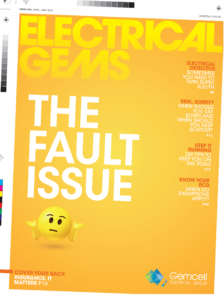Out Now
The AI Issue
Current Issue
The AI Issue
OCT - NOV 2025

There’s been plenty of talk about a big switchover from gas to electric, but what’s actually driving the shift?
Gas has been one of the key ways we’ve heated our homes, our hot water and fuelled our stove tops for a hell of a long time. After all, could you even say you could cook if you weren’t ‘cookin’ with gas’?!
But the times, they are indeed a’changin’, and you’ll no doubt have heard, read or watched some hard-hitting news item about gas being, well, gassed out.
So, what’s the story?
Well, it all boils down to a few things. Achieving net zero, of course, as well as cost – some of which stems from the war in Ukraine.
The Labor Government has been talking since 2022 about subsidies to move low-income households away from gas in favour of electricity. Indeed, the Greens declared, ‘Gas’s time is over!’ And, if we’re serious about getting to net zero by 2035, gas – as a polluting fossil fuel – will be phased out.
There’s a general understanding that we’re working towards an electrified future – some state governments are offering incentives for homes to replace gas appliances and fittings with electric ones, and the ACT is planning on being an all-electric state by 2045.
New ovens, cooktops, heaters, and hot water systems will need to be bought and installed (good news for electrical contractors…) and the old ones ditched and scrapped.
Research from One Big Switch suggests that households can save almost $10,000 over 12 years by switching from gas to electric appliances – however, when you factor in the cost of purchasing those new appliances, that saving decreases significantly.
And the cost issue is incredibly valid right now. Figures from the Australian Energy Regulator show the wholesale cost of gas has increased in Sydney, for example, from $6.49/GJ in 2019/20 to $22.38/GJ this year, while elsewhere in the country prices have increased similarly, which of course hits home hard – especially in the current economic environment.
There’s also a health concern too.
The ‘I Quit Gas’ initiative came after research showed that while 90 per cent of Australians understand the risks of tobacco and asbestos, only 32 per cent know that gas in the home is a significant health hazard thanks to leaking toxic gases.
So, what’s the real play here? On one hand, there’s a clear move to encourage renewable energy production, and ultimately, if most households are producing some or most of their own electricity, it ticks a few boxes for many.
The elephant in the room, though, is that Australia produces gas. Lots and lots (and lots, and lots) of gas. But a massive 80 per cent of that gas is exported. In fact, we’re in the top three exporters of liquid gas in the world, alongside the US and Qatar. Government policy has enabled many gas companies to export freely, meaning now we’re exposed to the volatility of the international market.
And, electricity prices have increased as gas is used to generate electricity.
So, ultimately, it seems the more we can move away from gas the better – however, it does leave questions about the impact increased demand will have on the grid….
There’s plenty of good news for contractors here. With a changeover to electric, goods installation will be required, while a greater reliance on renewable energy produced by each household will mean solar projects should keep on keeping on…
Keep up to date with our latest news and competitions by subscribing to our regular newsletter.

Issue 183
OCT - NOV 2024

Issue 182
AUG - SEPT 2024

Issue 181
JUN - JUL 2024

Issue 180
APR - MAY 2024

Issue 179
FEB - MARCH 2024

Issue 178
DEC 2023 - JAN 2024

Issue 177
OCT - NOV 2023

Issue 176
AUG - SEPT 2023

Issue 175
JUN - JUL 2023

Issue 174
APR - MAY 2023

Issue 173
FEB - MAR 2023

Issue 172
DEC 2022 - JAN 2023

Issue 171
OCT - NOV 2022

Issue 170
AUG - SEPT 2022

Issue 169
JUN - JUL 2022

Issue 168
APR - MAY 2022

Issue 167
FEB - MAR 2022

Issue 166
DEC 2021 - JAN 2022

Issue 165
OCT - NOV 2021

Issue 164
AUG - SEPT 2021

Issue 163
JUN - JUL 2021

Issue 162
APR - MAY 2021

Issue 161
FEB - MAR 2021

Issue 160
DEC 2020 - JAN 2021

Issue 159
OCT - NOV 2020

Issue 158
AUG - SEPT 2020

Issue 157
JUN - JUL 2022

Issue 156
APR - MAY 2020

Issue 155
FEB - MAR 2020

Issue 154
DEC 2019 - JAN 2020

Issue 153
OCT - NOV 2019

Issue 152
AUG - SEPT 2019

Issue 151
JUN - JUL 2019

Issue 150
APR - MAY 2019

Issue 149
FEB - MAR 2019

Issue 148
DEC 2018 - JAN 2019

Issue 147
OCT - NOV 2018

Issue 146
AUG - SEPT 2018

Issue 145
JUN - JUL 2018

Issue 144
APR - MAY 2018

Issue 143
FEB - MAR 2018

Issue 142
DEC 2016 - JAN 2017

Issue 141
OCT- NOV 2017

Issue 140
AUG - SEPT 2017

Issue 139
JUN - JUL 2017

Issue 138
APR - MAY 2017

Issue 137
FEB - MAR 2017

Issue 136
DEC 2016 - JAN 2017

Issue 135
OCT - NOV 2017

Issue 134
AUG - SEPT 2016

Issue 133
JUN - JUL 2016

Issue 132
APR - MAY 2016

Issue 131
FEB - MAR 2016

Issue 130
DEC 2015 - JAN 2016

Issue 129
OCT - NOV 2015

Issue 128
AUG - SEPT 2015

Issue 127
JUN - JUL 2015

Issue 125
APR - MAY 2015

Issue 125
FEB - MAR 2015

Issue 124
DEC 2014 - JAN 2015

Issue 123
OCT - NOV 2014

Issue 122
AUG - SEPT 2014

Issue 121
JUN - JUL 2014

Issue 120
APR - MAY 2014

Issue 119
FEB - MAR 2014

Issue 118
DEC 2013 - JAN 2014

Issue 117
OCT - NOV 2013

Issue 116
AUG - SEPT 2013


Comments (0)
Write a Comment